Thyroid Gland Solitary Fibrous Tumor: Report of 3 Cases and a Comprehensive Review of the Literature
Meaningful Value Added by Standardized, Internationally Validated, and Evidence-Based Pathology Data Sets for Cancer Reporting of Head and Neck Sites Coordinated by the International Collaboration on Cancer Reporting.
A Rainbow of Colors and Spectrum of Textures: An Approach to Oral Mucosal Entities.
Genetic Characteristics of Aldosterone-Producing Adenomas in Blacks
Radiographic nodal prognostic factors in stage I HPV-related oropharyngeal squamous cell carcinoma.
The HTN3-MSANTD3 Fusion Gene Defines a Subset of Acinic Cell Carcinoma of the Salivary Gland.
Hypothalamic Vasopressin-producing Tumors: Often Inappropriate Diuresis But Occasionally Cushing Disease.
Molecular Profiling of Salivary Gland Intraductal Carcinoma Revealed a Subset of Tumors Harboring NCOA4-RET and Novel TRIM27-RET Fusions: A Report of 17 cases.
CAIX and pax-8 Commonly Immunoreactive in Endolymphatic Sac Tumors: A Clinicopathologic Study of 26 Cases with Differential Considerations for Metastatic Renal Cell Carcinoma in von Hippel-Lindau Patients.
Sinonasal renal cell-like adenocarcinomas: robust carbonic anhydrase expression
ExpertPath and ImmunoQuery Webinar given by Dr. Lester D.R. Thompson
TIP: For sharpest focus, you may need to change YouTube’s default quality settings from Auto to 1080p60. Once you start the video, click the Settings cog icon near the lower right corner of video frame, select Quality and change Auto to 1080p. You should also click the Full Screen icon at the far right.

Carcinomas of the Oral Cavity (TNM8)
SCOPE:
The dataset has been developed for the reporting of resection and biopsy specimens of invasive carcinomas of the oral cavity, including lip and tongue. Mucosal melanoma, lymphomas and sarcomas are not included. In addition, neck dissections and nodal excisions are dealt with in a separate dataset, and this dataset should be used in conjunction, where applicable.
* Series Champion – Lester Thompson, USA
* Terrance Day, USA
* Kelly Magliocca, USA
* Mary Richardson, USA
* Philip Sloan, UK
* WM Tilakaratne, Sri Lanka
* Rosnah B Zain, USA
Mucosal Melanomas of the Head and Neck (TNM8)
SCOPE:
The dataset has been developed for the reporting of resection and biopsy specimens of mucosal melanoma arising in the nasopharynx, oropharynx, larynx, hypopharynx, oral cavity, nasal cavity and paranasal sinuses. All other malignancies and tumour categories are dealt with in separate datasets, specifically cutaneous melanoma is separately reported. Direct extension of a cutaneous primary into a mucosal site should be excluded, and would not be reported in this dataset. Metastasis to a head and neck mucosal site is also excluded. Neck dissections and nodal excisions are dealt with in a separate dataset, and this dataset should be used in conjunction, where applicable.
* Tim Helliwell, UK
* Susan Müller, USA
* Michelle Williams, USA
Carcinomas of the Nasopharynx and Oropharynx (TNM8)
SCOPE:
The dataset has been developed for the reporting of resection and biopsy specimens of the nasopharynx and oropharynx. The protocol applies to all invasive carcinomas of the nasopharynx and oropharynx including the base of tongue, tonsils, soft palate, posterior wall, and uvula. Lymphomas and sarcomas are not included. Neck dissections and nodal excisions are dealt with in a separate dataset, and this dataset should be used in conjunction, where applicable.
* Series Champion – Lester Thompson, USA
* Abbas Agaimy, Germany
* Diane Carlson, USA
* William Faquin, USA
* Tim Helliwell, UK
* Jos Hille, South Africa
* John Nicholls, Hong Kong
* Tony Ng, Canada
* Brian O’Sullivan, Canada
Carcinomas of the Nasal Cavity and Paranasal Sinuses (TNM8)
SCOPE:
The dataset has been developed for the reporting of resection and biopsy specimens of mucosal malignancies originating in the nasal cavities and paranasal sinuses. Neuroectodermal neoplasms (including melanoma) and sarcomas are not included. Bone, soft tissue and lymphoma protocols are separately listed. Neck dissections and nodal excisions are dealt with in a separate dataset, and this dataset should be used in conjunction, where applicable. For additional independent tumours, complete a separate dataset for each.
* Series Champion – Lester Thompson, USA
* Hedley Coleman, Australia
* Uta Flucke, Netherlands
* Lisa Licitra, Italy
* José L Llorente, Spain
* Edward Stelow, USA
* Mary Toner, UK
* Ilan Weinreb, Canada
Carcinomas of the Hypopharynx, Larynx and Trachea (TNM8)
SCOPE:
The dataset has been developed for the reporting of resection and biopsy specimens of mucosal malignancies of the larynx, hypopharynx and trachea. The protocol applies to all invasive carcinomas of the larynx, hypopharynx and trachea (including the supraglottis, glottis, and subglottis). Salivary-type malignancies arising from mucosal glands of the hypopharynx and larynx should be recorded in this dataset. Mucosal melanoma is presented in a separate dataset. Lymphomas and sarcomas are not included. Malignancies arising at other sites in the head and neck region, and neck dissections and nodal excisions are dealt with in separate datasets which may be used, as appropriate, in conjunction with this dataset. Where more than one anatomically or histologically distinct primary tumours occur, a separate dataset should be completed for each tumour.
* Series Champion – Lester Thompson, USA
* Jane Dahlstrom, Australia
* Nina Gale, Slovenia
* Jonathan McHugh, USA
* Bayardo Perez-Ordonez, Canada
* Nick Roland, UK
* Nina Zidar, Slovenia
Ear and Temporal Bone Tumours (TNM8)
SCOPE:
The dataset has been developed for the reporting of resection and biopsy specimens of the ear and temporal bone. It includes ONLY primary tumours of the external auditory canal, middle and inner ear, including both benign and malignant entities (specifically due to anatomic confines and management alternatives which may require significant, destructive or disfiguring surgery).
By definition, all malignancies of the external ear (pinna, concha, scaphoid, lobe, etc., such as squamous cell carcinoma, basal cell carcinoma, atypical fibroxanthoma, Merkel cell carcinoma and melanoma) are separately covered by the dermatopathology datasets.
Neck dissections and nodal excisions are dealt with in a separate dataset, and this dataset should be used in conjunction, where applicable. For bilateral tumours, a separate dataset should be completed for each tumour.
* Ann Sandison, UK
* Bruce Wenig, USA
Carcinomas of the Major Salivary Glands (TNM8)
SCOPE:
The dataset has been developed for the reporting of resection and biopsy specimens of malignant neoplasms and associated carcinoma in situ arising from the major salivary glands. The protocol applies to all carcinomas of the parotid, submandibular and sublingual glands. Melanomas, lymphomas, and sarcomas are dealt with in separate datasets. Minor salivary gland malignancies arising in the oral cavity, nasal cavity and paranasal sinuses, trachea, nasopharynx, oropharynx and hypopharynx and odontogenic specimens are staged according to their anatomical sub-site and are dealt with in separate datasets. In addition, neck dissections and nodal excisions are dealt with in a separate dataset, and this dataset should be used in conjunction, where applicable. For bilateral tumours, a separate dataset should be completed for each tumour.
* Series Champion – Lester Thompson, USA
* Robert L Ferris, USA
* Isabel Fonseca, Portugal
* Douglas Gnepp, USA
* Patrick Ha, USA
* Toshitaka Nagao, Japan
* Alena Skalova, Czech Republic
* Göran Stenman, Sweden
Malignant Odontogenic Tumours (TNM8)
SCOPE:
The dataset has been developed for the reporting of biopsy and resection specimens for malignant primary odontogenic tumours. Malignant neoplasms arising in the nasal cavity and paranasal sinuses, oral cavity, salivary glands, trachea, pharynx and larynx are dealt with in separate datasets. Bone, soft tissue and lymphoma protocols will be separately listed. In addition, neck dissections and nodal excisions are dealt with in a separate dataset, and this dataset should be used in conjunction, where applicable.
* Series Champion – Lester Thompson, USA
* Roman Carlos, Guatemala
* Keith Hunter, UK
* Adalberto Mosqueda-Taylor, Mexico
* Mary Richardson, USA
* Lee Slater, USA
* Pieter Slootweg, Netherlands
* Paul Speight, UK
* John Wright, USA
Nodal Excisions and Neck Dissection Specimens for Head & Neck Tumours (TNM8)
SCOPE:
The dataset has been developed for the reporting of lymph node resections from patients with carcinomas and melanomas of the head and neck. This excludes nodal resections for lymphoma and sarcomas. It is not intended for use in reporting lymph node core biopsy or fine needle aspirations. Carcinomas covered by the dataset include squamous cell carcinomas, sinonasal carcinomas, salivary and non-salivary type adenocarcinomas and neuroendocrine tumours. Pathologists may also apply the dataset to metastatic non-Merkel cutaneous squamous cell carcinomas and other cutaneous carcinomas. This dataset is to be used in conjunction with other datasets in the Head and Neck Series.
* Series Champion – Lester Thompson, USA
* Diane L. Carlson, USA
* Isabel Fonseca, Portugal
* Jennifer Hunt, USA
* Nora Katabi, USA
* Philip Sloan, UK
* S. Mark Taylor, Canada
* Michelle Williams, USA
Comparison of high-dose Cisplatin-based chemoradiotherapy and Cetuximab-based bioradiotherapy for p16-positive oropharyngeal squamous cell carcinoma in the context of revised HPV-based staging
findings.
Ectomesenchymal Chondromyxoid Tumor: A Neoplasm Characterized by Recurrent RREB1-MKL2 Fusions.
Noninvasive Follicular Thyroid Neoplasm with Papillary-Like Nuclear Features (NIFTP): Achieving Better Agreement by Refining Diagnostic Criteria
Measuring Depth of Invasion in Early Squamous Cell Carcinoma of the Oral Tongue: Positive Deep Margin, Extratumoral Perineural Invasion, and Other Challenges.
doi: 10.1007/s12105-018-0925-3. Epub 2018 Apr 26.
Diagnostic Approach to Fine Needle Aspirations of Cystic Lesions of the Salivary Gland
Dentigerous cyst
Noninvasive follicular thyroid neoplasm with papillary-like nuclear features (NIFTP) in thyroid tumor classification.
Head and Neck Kaposi Sarcoma: Clinicopathological Analysis of 11 Cases.
An International Interobserver Variability Reporting of the Nuclear Scoring Criteria to Diagnose Noninvasive Follicular Thyroid Neoplasm with Papillary-Like Nuclear Features: a Validation Study
Induction chemotherapy followed by concurrent chemoradiation versus concurrent chemoradiation alone in the definitive management of p16-positive oropharyngeal squamous cell carcinoma with low-neck or N3 disease
Sinonasal Tract Solitary Fibrous Tumor: A Clinicopathologic Study of Six Cases with a Comprehensive Review of the Literature.
Epithelial-Myoepithelial Carcinoma: Frequent Morphologic and Molecular Evidence of Preexisting Pleomorphic Adenoma, Common HRAS Mutations in PLAG1-intact and HMGA2-intact Cases, and Occasional TP53, FBXW7, and SMARCB1 Alterations in High-grade Cases.
Sinonasal Leiomyosarcoma: Clinicopathological Analysis of Nine Cases with Emphasis on Common Association with Other Malignancies and Late Distant Metastasis.
Nasopharyngeal papillary adenocarcinoma.
Localized Nasopharyngeal Amyloidosis: A Clinicopathologic Series of 7 Cases with a Literature Review
Pathologic reporting of Tall Cell Variant of Papillary Thyroid Cancer: Have we reached a consensus?
Noninvasive follicular thyroid neoplasm with papillary-like nuclear features: a review for pathologists.
Long-term follow-up of a patient with malignant transformation of inverted papilloma into sinonasal undifferentiated carcinoma.
Ear fetal rhabdomyoma.
Improving margin revision: Characterization of tumor bed margins in early oral tongue cancer.
Diagnostic Immunohistochemistry: Theranostic and Genomic Applications, Expert Consult [Sixth Edition]
![Diagnostic Immunohistochemistry: Theranostic and Genomic Applications, Expert Consult [Sixth Edition]](http://lesterthompsonmd.com/stuff/uploads/Diagnostic-Immunohistochemistry-6th-Edition-cover-lg.jpg) 6th Edition (current)
6th Edition (current)David J. Dabbs, MD
(Lester D.R. Thompson, MD, contributor)
- Paperback: 1000 pages
- Publisher: Elsevier; 6th edition (December 17, 2021)
- Language: English
- ISBN-10: 0323721729
- ISBN-13: 978-0323721721
- Product Dimensions: 8.8 x 1.7 x 11.1 inches
Buy this book
Read the Publisher’s Description
![Diagnostic Immunohistochemistry: Theranostic and Genomic Applications, Expert Consult [Fifth Edition]](http://lesterthompsonmd.com/stuff/uploads/Diagnostic-Immunohistochemistry-Dabbs-cover-5th-ed.jpg) 5th Edition
5th Edition ![Diagnostic Immunohistochemistry: Theranostic and Genomic Applications, Expert Consult [Fourth Edition]](http://lesterthompsonmd.com/stuff/uploads/books-DI-2017-med.jpg) 4th edition
4th editionSinonasal Tract Alveolar Rhabdomyosarcoma in Adults: A Clinicopathologic and Immunophenotypic Study of Fifty-Two Cases with Emphasis on Epithelial Immunoreactivity.
Metastases to the Parathyroid Glands: A Comprehensive Literature Review of 127 Reported Cases.
Ectopic Hamartomatous Thymoma: A Review Of The Literature With Report Of New Cases And Proposal Of A New Name: Biphenotypic Branchioma.
Lobular capillary hemangioma (pyogenic granuloma) of the oral cavity.
World Health Organization Classification of Tumours of Endocrine Organs, 4th Edition
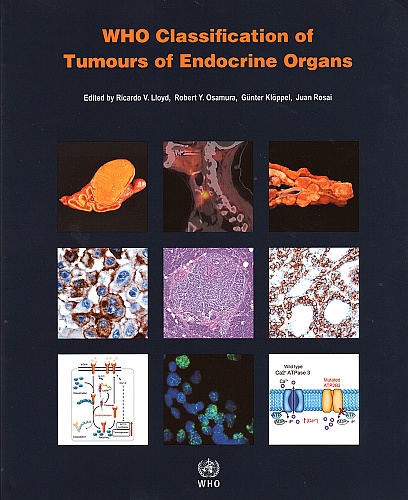 Current 4th Edition
Current 4th EditionRicardo V. Lloyd, MD • Robert Y. Osamura, MD • Günter Klöppel, MD • Juan Rosai, MD
(Lester D.R. Thompson, MD, contributor)
- Paperback: 355 pages
- Publisher: World Health Organization (IARC); 4th Edition (2017)
- Language: English
- ISBN-10: 9283244931
- ISBN-13: 9789283244936
Read the Publisher’s Description
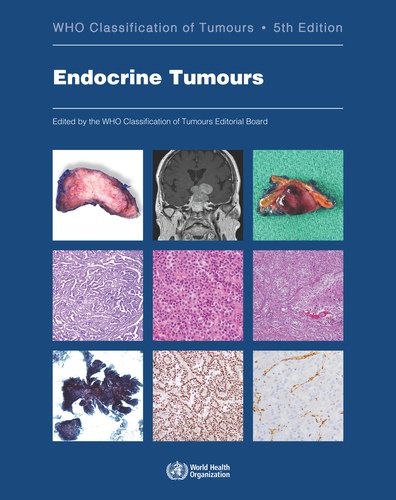
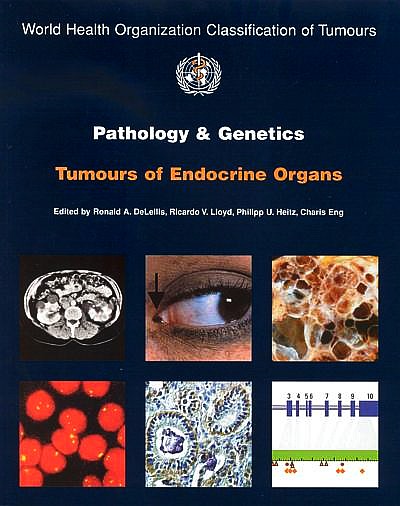
AFIP Atlas: Tumors of the Salivary Glands (Fifth Series, Vol. 5)
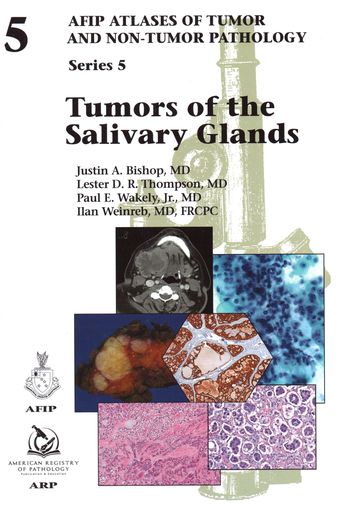
Justin A. Bishop, MD • Lester D.R. Thompson, MD • Paul E. Wakely, Jr., MD • Ilan Weinreb, MD
Information:
- Hardcover: 719 pages
- Publisher: ARP Press; 1st edition (2021)
- Language: English
- ISBN-10: 1-933477-94-6
- ISBN-13: 978-1-933477-94-7
- Product Dimensions: approx. 8.75 x 1.375 x 11 inches
Buy this book from the Publisher
Publisher’s description:
This book serves as a one-stop, comprehensive reference for the pathology of salivary gland neoplasms, with an emphasis on numerous high-quality, illustrative photomicrographs. The authors incorporated the most cutting-edge genetic data emerging on such tumors, as this information often has a profound impact on their diagnosis and classification. With the quickly evolving nature of salivary gland pathology, this contribution to the Fifth Series is a key update to the previous edition from the Fourth Series, which was published in 2008.
Non-Neoplastic Diseases of the Head and Neck, (1st series, Vol. 11)
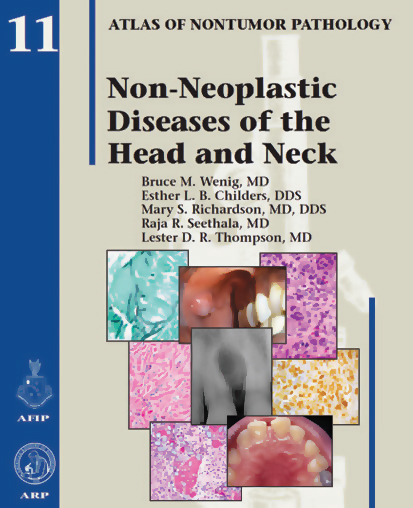
Bruce M. Wenig, MD • Esther L. B. Childers, MD • Mary S. Richardson, MD • Raja R. Seethala, MD • Lester D.R. Thompson, MD
Information:
- Hardcover: 491 pages
- Publisher: ARP Press; 1st edition (2017)
- Language: English
- ISBN-10: 1-9334-77-37-7
- ISBN-13: 978-1-933477-37-4
- Product Dimensions: approx. 8.75 x 1.125 x 11 inches
Buy this book from the Publisher
Buy this book from Amazon
Read the Publisher’s description
